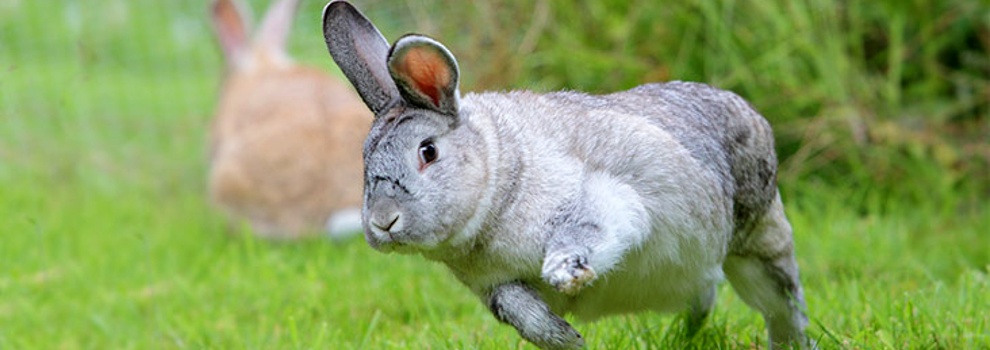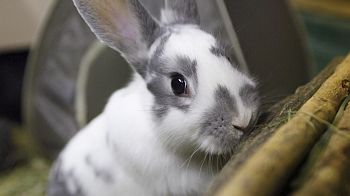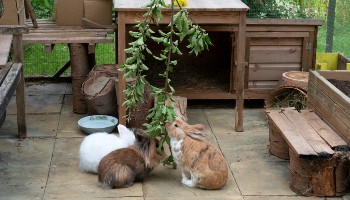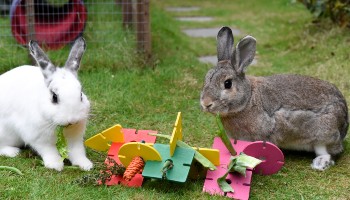Show-jumping with your rabbit
You should only train your rabbit to start showjumping after carefully thinking about whether it's in your pet's best interests. If you decide to try showjumping with your rabbit, you'll need to make sure they're well looked after at all times.
Not all rabbits are suited to show-jumping
Many rabbits lack the build or athletic ability to take part, and unfit rabbits could injure themselves jumping. They could also be too shy or un-socialised and find it stressful. Young rabbits can't take part until their bones and joints are well developed and strong.
When you're deciding if it's right for your rabbit, bear in mind that there are likely to be lots of people, noise and camera flashes at agility events.
Agility may not be right for long-haired rabbits because of problems with movement or for lop-eared rabbits because of the risk of damage to their ears.
Always speak to a vet before starting any agility training to make sure your rabbit is physically fit and a suitable age. The vet can tell you if they think your rabbit would benefit from agility training.
Training your rabbit
Rabbits are intelligent, inquisitive and playful. They can be litter trained, learn to use cat flaps, and taught various tricks such as coming when called, entering their shelter on cue, and fetching objects.
If you're an inexperienced owner, try some basic training first, such as encouraging your rabbit to come when called. Reward them with a healthy treat. See whether your rabbit responds well to this before trying more complex training activities, like agility courses.
The style of training is important. Never use punishment, such as shouting or physical coercion, to train a rabbit. Only use positive reward-based methods, such as clicker training. This is a popular method used to train animals including rabbits, but it’s important that it’s done correctly. You use the clicker to tell your rabbit they've done the right thing. To begin with, a click is always followed by a reward, such as a treat, as this helps your rabbit have good associations with the action. Over time you can reduce how often they get a separate reward as the click becomes a reward in itself.
You should also use positive reinforcement when training your rabbit to wear a harness. They should feel comfortable in their harness before you start agility training. Leads need to be long enough to let them jump easily.
You can create an agility course in your garden instead of taking your rabbit to shows. Be sure to get expert advice from a vet or rabbit behaviourist on the equipment you'll need, as well as the safety of jumps, ramps and tunnels. They can also make sure that leads and harnesses are suitable and well-fitted.
Rabbit agility shows and competitions
Rabbit welfare should be the top priority before, during and after rabbit agility events. A vet should be present at all shows to check on animals and look after them if they are injured. Make sure your rabbits are up to date with all their vaccinations as diseases can spread when there are a lot of animals close together.
Both you and the event organiser should think about potential welfare problems and do what you can to keep your rabbit healthy, happy and stress-free throughout the event. Monitor your rabbit before, during and after the event and watch out for signs they’re unhappy or stressed. If they’re stressed, give them a break in a quiet area.
Housing at the show should be safe with enough room for the rabbits to stretch out, turn around, stand on their hind legs and hop. They’ll need hiding places that they can retreat to. If there are other animals at the show who could be predators (such as dogs, cats, ferrets and birds of prey), make sure your rabbit can’t see or smell them.
Give your rabbits plenty of rest time and keep them in a quiet, shady area when not taking part in the event. They need to be away from direct sunlight or heat and have access to food and water at all times.
Travel
Travelling to and from shows can be stressful for rabbits, especially if it’s a long way or they're travelling by air. Transport rabbits with their usual companions and put items from their home in the carrier as the smell will be familiar. Check that the vehicle is a comfortable temperature during the whole journey. And make sure your rabbit has plenty of time to rest after the journey, before they take part in the event. You can find more information on transporting your rabbits here.
Travel
If the rabbits have been separated, gradually reintroduce them. You could rub a cloth over the rabbit who was at the show event and then rub it over the rabbit(s) left at home. Next, let them meet in a neutral setting under your supervision, with hiding places and enrichment. You can house them together again once they’re happy and settled in each other’s company.




